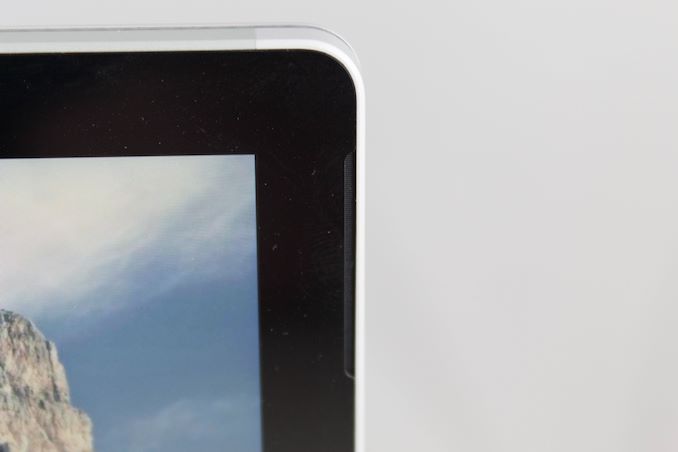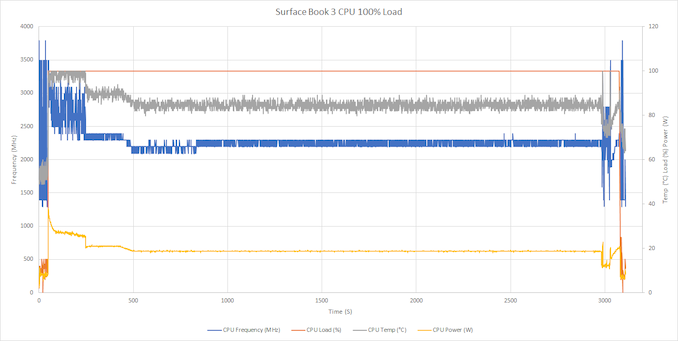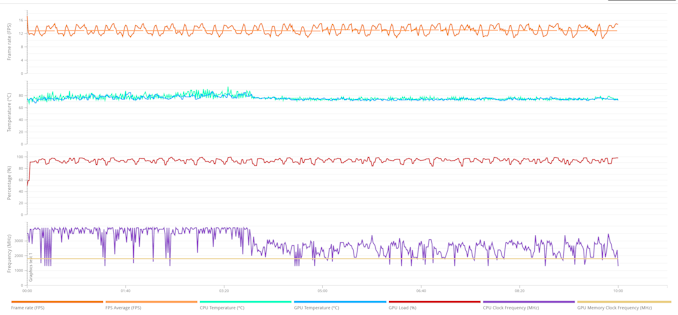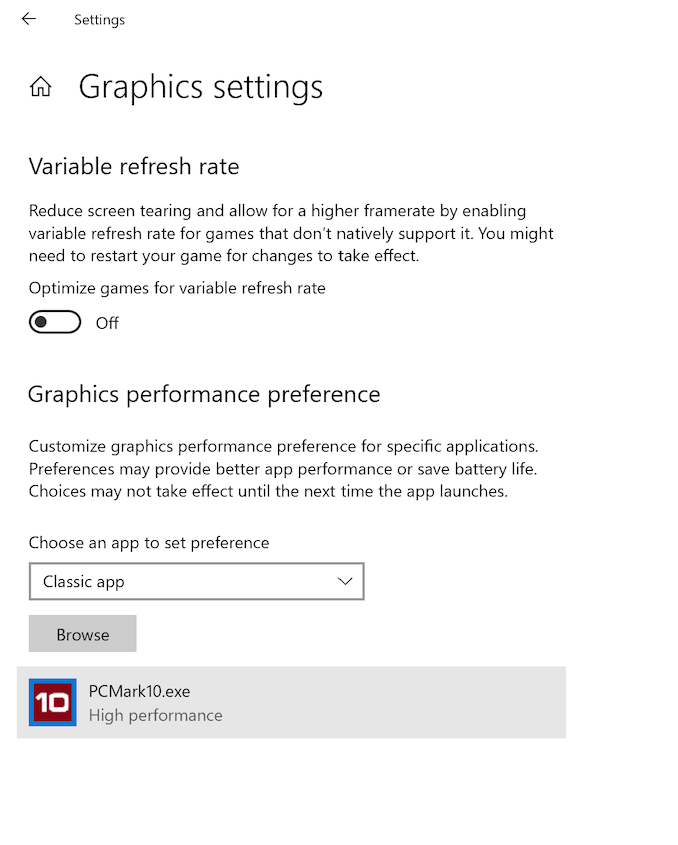The Microsoft Surface Book 3 (15-Inch) Review: A Refreshing Dip Into Ice Lake
by Brett Howse on June 3, 2020 9:00 AM ESTWireless
For the past several generations, Microsoft has leveraged Marvell networking adapters, unless the device had LTE, in which case they tended to use Qualcomm. Unfortunately, both were prone to unreliability and could not keep up with sustained transfer speeds like the latest Intel wireless solutions. Now that Wi-Fi 6 is upon us, the trend seems to be for everyone to use Intel wireless, including the Surface lineup. The Surface Book 3 features the Intel AX201 Wi-Fi 6 network adapter, which is a 2x2:2 design with the full 160 MHz channel width support.

The speeds are fantastic, and Intel has continued offering their very solid drivers too, so reliability has been top-notch. Although competition is always welcome, in the PC space there is really one standout wireless solution, and this is it.
Audio
Microsoft outfits the Surface Book 3 with front-facing stereo speakers featuring Dolby Atmos. As is typical of the Surface speakers, they blend almost seamlessly into the display bezel meaning they are almost invisible to the eye. There are also dual far-field microphones for dictation, or conferencing.
Sound quality of the speakers is excellent, and although they only achieved around 73dB(A) of SPL, the range of the speakers were quite impressive.
Thermals
The two-zone thermals of the Surface Book 3 mean that the temperature of the CPU will not impact the GPU, and vice versa. It also means that Microsoft has more room for a larger GPU, which we’ve seen the results of in our GPU testing. The CPU side with the Core i7-1065G7 has a thermal design of 15 Watts, meaning the processor is designed for a stead-state thermal load of 15 Watts, but with Intel’s aggressive Turbo, processors will draw much more than that for short bursts. On the GPU side, NVIDIA rates the GTX 1660 Ti Max-Q at between 65 and 80 Watts, depending on implementation.
The Surface Book 3 was subjected to a full CPU stress test, while monitoring the frequency and power draw of the processor. Interestingly, the processor very quickly bumps into the 100°C thermal limit, causing the processor to throttle at the start of the test during the PL1 stage of the CPU, which peaks at about 38 Watts maximum and 100°C. When PL1 ends and the processor moves into PL2, the power draw drops to a steady state value of around 19 Watts. So the Surface Book 3 can easily handle the full TDP of the processor, but it does not quite have enough to handle the full limit Microsoft implemented for PL1. This likely means there is not enough heatsink mass to handle the initial burst, although there is enough dissipation to handle the processor under load. As a comparison point, the Surface Laptop 3 with the same processor managed about 43 Watts at PL1 and it never quite reached the 100°C thermal cut-off, and then had a steady state of over 20 Watts. The overall cooling system is unsurprisingly not quite as capable as a more traditional laptop design, at least for the processor.
On the GPU front the Surface Book 3 also performs quite well. Unfortunately, our normal data logging tool was unable to read the GTX 1660 Ti, so instead we ran 20 loops of the 3DMark Fire Strike stress test. The GPU temperatures peaked at around 85° and settled in around 75°, with consistent FPS throughout the 20 loops.
One of the most amazing things about the Surface Book 3 thermals is how much performance there is considering the noise level. At full load after over an hour of use, the Surface Book 3 registered at only 43 dB(A) measured one inch over the trackpad. The tone of the noise is also low enough that it is very easy to live with. Despite not being able to get peak performance out of the CPU for a short window, the cooling system still does a great job and without much noise at all.
Software
One of the best perks of the Surface lineup is that there is no extra software installed to deal with, unless you include the unfortunate fluff that has started shipping directly in Windows. But as Surface is Microsoft’s device lineup, the Surface team also tends to bring new tech to Windows. For the Surface Laptop 3, that is the ability to choose the graphics adapter for each program directly in the Windows Settings. Previously, the NVIDIA Control Panel was required.
Branding of classic applications and UWP applications aside, it is nice to see this brought into Settings since it would be available for all GPU vendors and not require a proprietary tool.
Microsoft also includes the Surface App where you can see details about your device, battery levels of connected Surface peripherals, and get support.
Most laptops ship with some sort of tool for this function now, but the Surface one definitely has more polish than most.















125 Comments
View All Comments
Icehawk - Wednesday, June 3, 2020 - link
And don’t forget if they drain the battery you can’t plug them into a dock to turn it on, you need to use a standalone charger to get it up to 10% or so first. Ugh I am not a Surface fan AT ALL. I’ve supported almost all of the models.pjcamp - Wednesday, June 3, 2020 - link
I don't give a crap about bezels and I doubt anyone else does either, beyond tech pundits and reviewers who need something trendy to criticize. In fact, for devices to be held in the hands, like phones and tablets, bezels are a feature, not a bug, as they limit accidental activations.I own an original Surface Book, and I have a few observations about its durability.
In the end, the detachable form factor is not a good idea. It means if you want to get inside, you have to pry off the screen, a dicey proposition. It is fussy and fumbly to switch back and forth, which you really need to do if you need to change between drawing and typing as drawing in laptop mode is made quite difficult by the screen wobbling back and forth. It's best to think of this as a pure laptop.
The build quality is suspect. I've actually owned three of these things due to warranty replacements. Each of the previous ones had a power button that got stuck in the on position.
Also, I don't detach the screen very much, but the connection on all three computers became wonky. Suddenly it no longer sees the keyboard any more and announces that it is in tablet mode.
The memory wire attachment mechanism is clever, but it has gotten to the point that it doesn't work consistently. And the only recourse then is to find the one and only vent hole on the side that allows you to push a paper clip in at a 45 degree angle to force a manual release. That is clearly designed to prevent you from using it.
Batteries are not eternal but at this point my battery life with keyboard attached is down to less than two hours. That seems like an awfully quick degradation, as these things go.
The only thing that is an unmitigated good about these device, and it is a big thing, is the hi res 3:2 screen. If only Microsoft could make Windows scale appropriately instead of relying on each app to do it independently.
Spunjji - Thursday, June 4, 2020 - link
This pretty much summarises my understanding of the devices, from a support perspective... they're just fussy. Over-engineered would be another way of putting it. Impossible to repair, fragile, and generally not suited to regular use "in anger".A damn shame, really, as I like the concept.
Deicidium369 - Friday, June 5, 2020 - link
I am not sure about them being fragile - have had 10 or 11 deployed in the field, and they can at times take a beating - no failures in ~2 years - I have had my older model for going on 4, although doesn't get used that much anymore... still no issues.Spunjji - Friday, June 5, 2020 - link
Your ~11 beats my 2, but of those 2 both failed - and one had intermittent GPU driver issues even when it was working.amb9800 - Wednesday, June 3, 2020 - link
The GTX 1660 Ti Max-Q seems to be delivering better performance than expected (especially given it's a 65W part, vs. the 80W GTX 1060 Max-P in the Surface Book 2 15"), so it's not a completely worthless spec bump.That said, this would've been the perfect use case for the Ryzen 4000 U-series CPUs. Equipping the Surface Book 3 with a Ryzen 7 4800U would've allowed for performance on par with 45W 6/8-core Intel-based 15" competitors but within the Surface's 15-25W TDP budget.
Intel Ice Lake U-series is by far the biggest disappointment on this machine -- it (along with every other premium Intel-powered ultrabook) gets destroyed by the 4700U-powered $650 Acer Swift 3. The performance picture gets even worse when you look at, say, the Asus ROG Zephyrus G14, which ups the ante with the desktop-killing Ryzen 9 4900HS for under $1,500 -- with a 14" screen, solid battery life, and lower weight than even the 13" Surface Book 3.
lmcd - Thursday, June 4, 2020 - link
It's completely idiotic to compare a part that fits in a tablet form factor with a laptop sporting a 35W CPU. Whether the form factor is dumb or not is a different question.Worth remembering that Intel has delivered a "true SoC" platform for quite some time now. AMD's past CPUs, by comparison, weren't "true SoC" platforms and weren't even candidates to fit on this size of board. Ryzen 2x00U had an idle power bug across the platform, further removing it from candidacy.
That means the first AMD SoC the Surface Book team might've had the chance to integrate is the 3x00U. Based on how long it took for MS to integrate Ice Lake, the Surface Book 3 wouldn't get the 4700U until Christmas or later. Possibly longer considering that the 4700U is a more substantial change than Ice Lake vs past Intel SoCs.
lmcd - Thursday, June 4, 2020 - link
Yea just found this from the Renoir intro:"AMD’s latest Ryzen mobile product is the first design the company has done that combines CPU, GPU, and IO all on a monolithic die in TSMC’s 7nm process."
Indicating that IO wasn't entirely on-board before. Surface Book 4 could theoretically have a Ryzen design.
Deicidium369 - Friday, June 5, 2020 - link
Would imagine that the 1 AMD design they have would be sporting the 4000 series - wonder how much of a new design was needed to support it. Thermals would be better on the 4000 vs the older designSpunjji - Friday, June 5, 2020 - link
I think you've misinterpreted that - Renoir is the first AMD SoC that combines all of that *on 7nm*. I'm fairly sure Raven ridge included USB, SATA etc on-die - that's how the A300 Promontory "chipset" in the ASRock A300 does its thing.Wouldn't surprise me if the SoC had a larger package area than the Intel competitors, though. Intel have been working hard on that aspect for a few generations now.